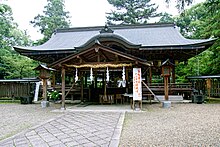User:Immanuelle/Nunaki-iri-hime
| This user page or section is currently being expanded by an editor. You are welcome to help in expanding too. If this page has not been changed in several days, please remove this template. This page was last edited by Immanuelle (talk | contribs) 8 months ago. |
This article may be expanded with text translated from the corresponding article in Japanese. Click [show] for important translation instructions.
|
| Immanuelle/Nunaki-iri-hime | |
|---|---|
 She was the first priestess of Ōyamato Shrine but was replaced | |
| Successor | Ichishi no Nagaochi |
| House | Imperial House of Japan |
| Father | Emperor Sujin |
| The English used in this user page may not be easy for everybody to understand. You can help Wikipedia by reading Wikipedia:How to write Simple English pages, then simplifying the page. |
| This is a draft being worked on by Immanuelle. It may be too complex at the moment but she wants to get it ready to be an article someday. Others are free to edit it This page was last edited by Immanuelle (talk | contribs) 8 months ago. |
Nunaki-iri-hime (渟名城入姫命) was a Japanese Princess.[1]
Overview
changeThe main source for the biography of Nunaki-iri-hime is the Nihon Shoki.[2] Similar events also covered by the Kogo Shūi.[3]
The narrative relates that pestilence struck during the 5th year of Sujin's rule, and ultimately killed half of the Japanese population. Peasants abandoned their fields in the following year, and rebellion became rampant after eventual events Sujin placed his daughter Toyosukiiri-hime (豊鍬入姫命) in charge of the new shrine, where she would become the first Ise Saiō, .[1].[1][a] [5].[2][3] Meanwhile, Yamato Okunitama was entrusted to another daughter named Nunaki-iri-hime, but shortly afterwards, her health began to fail. It is recorded that she became emaciated and lost all of her hair, which rendered her unable to perform her duties.[1] These efforts still did not alleviate the ongoing plague, so Sujin decreed that a divination be performed sometime during the 7th year of his reign, that would involve him making a trip to the plain of Kami-asaji, and invoking the eighty myriad deities.[1] This mode of worship is seen as being potentially linked to a social order of greater complexity, and the organization of the deities of the many clans across the region.[6]
After these events, Sujin's aunt Yamatototohimomoso-hime (倭迹迹日百襲媛命), the daughter of the seventh emperor Emperor Kōrei, acted as a Miko, and was possessed by a god who identified himself as Ōmononushi,[1][7] possibly the same entity as Yamato Okunitama. Ichishi no Nagaochi would conduct the rites pertaining to Okunitama, replacing the emaciated Nunaki-iri-hime.[7] Ichishi no Nagaochi would be the ancestor of the Yamato no Kuni no Miyatsuko.[8] This replacement is taken as a shift towards a more patriarchal religion.[7]
Genealogy
changeNotelist
change- ↑ During the reign of Sujin's successor Emperor Suinin, custody of the sacred treasures were transferred from Toyosukiirihime to Suinin's daughter Yamatohime, who took them first to "Sasahata in Uda" to the east of Miwa. Heading north to Ōmi Province, she then traveled eastwards to Mino Province, then south to Ise Province, where she received a revelation from Amaterasu:
Now Ama-terasu no Oho-kami instructed Yamato-hime no Mikoto, saying:—"The province of Ise, of the divine wind, is the land whither repair the waves from the eternal world, the successive waves. It is a secluded and pleasant land. In this land I wish to dwell." In compliance, therefore, with the instruction of the Great Goddess, a shrine was erected to her in the province of Ise. Accordingly an Abstinence Palace was built at Kaha-kami in Isuzu. This was called the palace of Iso. It was there that Ama-terasu no Oho-kami first descended from Heaven.[4]
This account serves as the origin myth of the Ise Grand Shrine, Amaterasu's chief place of worship.
References
change- ↑ 1.0 1.1 1.2 1.3 1.4 1.5 Aston, William George. (1896). Nihongi: Chronicles of Japan from the Earliest Times to A.D. 697, Volume 2. The Japan Society London. pp. 150–164. ISBN 9780524053478.
- ↑ 2.0 2.1 " Book I". Nihongi: Chronicles of Japan from the Earliest Times to A.D. 697. Kegan Paul, Trench, Trübner & Co.. Wikisource. 1896. 151-154.
- ↑ 3.0 3.1 Kogoshūi: Gleanings from Ancient Stories. Translated with an introduction and notes. Translated by Katō, Genchi; Hoshino, Hikoshirō. Meiji Japan Society. 1925. pp. 29–30.
- ↑ " Book I". Nihongi: Chronicles of Japan from the Earliest Times to A.D. 697. Kegan Paul, Trench, Trübner & Co.. Wikisource. 1896. 176.
- ↑ https://d-museum.kokugakuin.ac.jp/eos/detail/?id=8608
- ↑ "Contents", Himiko and Japan's Elusive Chiefdom of Yamatai, University of Hawaii Press, pp. 189–191, 2017-12-31, ISBN 978-0-8248-6284-8, retrieved 2023-10-24
- ↑ 7.0 7.1 7.2 Ellwood, Robert S. (1990). "The Sujin Religious Revolution". Japanese Journal of Religious Studies. 17 (2/3): 199–217. ISSN 0304-1042.
- ↑ "Page:Nihongi by Aston.djvu/208 - Wikisource, the free online library". en.wikisource.org. Retrieved 2023-10-24.